Tong lau
The term tong lau or ke lau (Chinese: 唐樓 / 騎樓; pinyin: tánglóu / qílóu) is used to describe tenement buildings built in late 19th century to the 1960s in Hong Kong, Taiwan, Southern China and South East Asia. Designed for both residential and commercial uses, they are similar in style and function to the shophouses with five foot way of Southeast Asia. Over the years, tong lau construction has seen influences of Edwardian style architecture and later the Bauhaus movement.
Overview
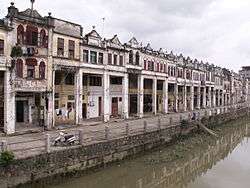
Tong lau (Cantonese) or tang lau (Mandarin) means "Chinese building" – Tong or Tang (唐) refers to the Tang dynasty and is used as a term to mean Chinese, and lau (樓) is a building with more than one floor. It is a general term for a type of building found in Hong Kong that also developed in Macao and Guangzhou from traditional Southern Chinese townhouses. The early buildings were generally long and narrow with width of between 12–15 feet determined by the length of the wooden beams.[1] In Hong Kong's building regulations, it refers a building with any living space intended for more than one tenant.[2] It is essentially a tenement building for residential and commercial use. The ground floor is reserved for commercial use, mostly by small businesses like retail shops and food vendors. The upper floors were residential use and catered to Chinese residents of Hong Kong. Most early tong lau were 2–4 storeys tall because building regulations that initially limited the height of building to 1.25 times the width of the street with a maximum height of 35 feet. However, due to the influx of migrants from mainland China to Hong Kong in the 1950s, height control of buildings was relaxed in 1955, and some tong laus that were built after that may have 9 or more floors, and built without lifts.[3] The heyday of tong lau ended in the 1960s when population pressure resulted in many tong laus being demolished to make way for high-rise buildings and changes in building ordinance that allow for such high-rise buildings.[4]
Ke lau or qilou (Chinese: 騎樓. meaning "riding building"), is a form of tong lau with an arcade running alongside the road for pedestrian use. The term was originally "qilou with feet" (有脚騎樓, youjiao qilou), which was first used in Guangzhou's building regulations in 1912, and referred to the columns forming the colonnade that supported the projecting floors that "ride" above. The qilou buildings developed in Guangzhou were influenced by local traditions and the shophouses with five foot ways of Singapore first built under the instructions of Stamford Raffles in his town plan enacted soon after the founding of the colony in the early 19th century. Qilous were built in Southern China (Guangdong, Guangxi and Fujian) starting in the early 20th century. Most of the qilous in Guangzhou were built in the 1930s until the outbreak of the Sino-Japanese war, and few were built after that period.[5]
Early tong lau
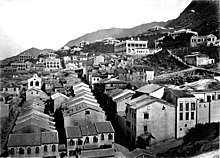
The early tong lau in Hong Kong were mainly two- or three-storey structures built back-to-back, and built in areas such as Tai Ping Shan. 19th century tong lau encompassed Chinese and European architectural features. The Chinese component was based on building design from southern China, mainly in Guangdong Province. European influences were usually Neoclassical. The tong lau roof used wood and/or Xieding tiles and iron was used for the balconies. The balcony's design was based on Cantonese styles. Windows used French styling and were made of wood and glass. The upper floors were supported by brick pillars and protruded out to the edge of the street.
Inside, the floors were connected by wooden stairs. Most floors ranged from 450–700 square feet with very high ceilings. Top floors were often living quarters for shopkeepers and their family.
Other architectural features of early tong laus:
- granite capped balustrades
- decorative urns on the roof
- wooden floors and joists
- Canton floor tiles
In 1903, in response to an outbreak of bubonic plague, the Hong Kong government issued a set of new regulations for tong lau so as to improve the living condition of those in these buildings. New tong lau buildings needed to have a light well, have larger windows, and the buildings were limited to four floors so their residents can receive sufficient light. The frontage were set at 15 feet, and at the back there needed to have a 6-foot lane to remove back-to-back constructions. Roof tiles were also replaced by flat concrete roofs.[6]
In the 1920s, reinforced concrete began to be introduced as the main structural element, which allowed for verandah and cantilevered or recessed balconies to let in extra light.[6] An example of early tong lau or Kee-lau is Lui Seng Chun, a building in reinforced concrete built in Hong Kong in 1931.[7]
Post War tong lau
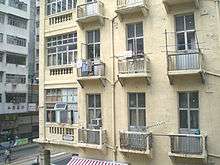
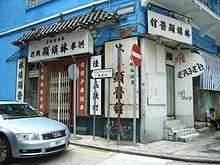
Tong lau built after World War II were simpler in design:
Iron balconies were replaced with concrete ones and later sealed with windows. Roofs were often flat with an open terrace and later renovated to allow for additional residential space. Wooden windows gave way to stainless steel windows. Air conditioning units were added to the windows in the 1970s and 1980s. Often clothes racks were added below the windows and hung above the sidewalk or street below. Signs were hung on the exterior walls and protruded onto the streets below.
Other features of the new tong lau included:
- mosaic floor tiles
- terrazzo staircase
The post-war boom and influx of immigrants led to a shortage of housing in Hong Kong. Many tong lau were renovated to become rental units. In order to become spacious space, each unit was separated from adjacent units through brick party walls, is between 13 and 16 feet wide (about 4 to 5 m).[8]
The ground floor of a tong lau was used as shop space, but a cockloft was often built on the upper space in front of the partition wall of the kitchen, or utilized as working area. Rooms on the upper floors were divided into smaller rooms and sublet as units by owners. They would only accommodate bunk beds. The middle of the floor was common space for tenants to eat and use. Bathrooms and kitchens were also shared amongst the tenants on each floor. Tenants paid for electricity and water on a monthly basis.[8]
The sublet of floors in the tong lau led to changes in housing regulations in Hong Kong.
After the 1960s, many tong lau were demolished to give way to taller apartment and commercial buildings, especially new town or private apartment. Few tong Lau are relatively found in Hong Kong today.[9]
On 29 January 2010, no. 45J Ma Tau Wai Road, Ma Tau Wai, a five-storey tong lau of more than 50 years history, suddenly collapsed at approximately 1:43 pm. Four people were killed. Such spontaneous, cascading and complete building collapse in Hong Kong has been quite rare since the Second World War and the incident raised concern of the HKSAR Government and the Hong Kong public towards the safety of the aging tong lau in Hong Kong, especially those built with similar specifications 50 or more years ago.[10]
Mainland China
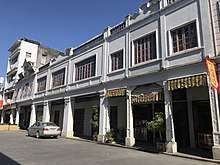
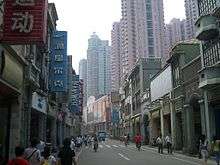
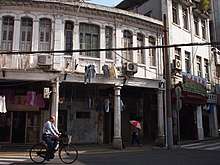
Qilou styles varied from Chinese to European:
- Gothic Style
- Nanyang (Southeast Asia) Style
- Ancient Roman Gallery Style
- Imitation Baroque Style
- Modernisme
- Traditional Chinese Architectural Style
Guangdong
Southern China, namely cities in Guangdong Province, is where the tong lau and qilou originated. They were built by wealthy Chinese merchants in the cities like Guangzhou and, with the aid of overseas Chinese, in emigrant market towns like Chikan, Kaiping.[11]
Locations in Guangzhou with Qilou:
- Renmin Zhong Road
- Renmin Nan Road
- Shangxiajiu Pedestrian Street, including Dishifu Road
- Yide road especially area around the Sacred Heart Stone House Cathedral
- Wanfu Road
- Taikang Road
- Xinhua Bookstore of Science and Technology on Beijing Road
- Oi Kwan Hotel on Yanjiangxi Road
- 186 Wenming Road
- 139 Dezheng Nan Road
Hainan and Guangxi
As both Hainan Island and the eastern part of the Guangxi Province lie in the broader Cantonese sphere of linguistical and cultural influence and historically were part of Guangdong, several cities and towns also have this kind of architecture.
Beihai
The city of Beihai lies on the coast in Guangxi. The Old Sheng Ping Street (升平街旧址) is lined with qilou architecture. Life and trade thrived here in the 19th century. Today it's full of restaurants, souvenir shops and adorned with sculptures and boards with information about local culture.
Haikou
The historical Bo'ai Road area is located in the heart of the Hainan capital city of Haikou. Nearly all the buildings in this neighbourhood are tong lau style. Beginning around 2012, the entire area has been undergoing restoration. It started with Zhongshan Road, now completed and converted into a pedestrian zone. The restoration is currently expanding outward with the facades being replastered and painted. Lights facing toward the facades to illuminate them at night are now installed on many of the buildings. With road repair ongoing, and new, tourist-related businesses replacing the old shops, the entire area is being developed as a visitor attraction.
Chengmai
The southern part of the town of Chengmai, located in Chengmai County, has a neighbourhood running along the Nandu River that consists of numerous, dilapidated tong lau buildings.
Wenchang
The tong lau buildings in the city of Wenchang's "Wennan Old Street" have been completely restored. Unlike Haikou's Bo'ai Road area, the facades are unpainted and appear gray in colour. The area is located downtown and is a visitor attraction.
Puqian
An area within the town of Puqian, mostly consisting of a single street, is lined with tong lau buildings. The street is the main route from the port to the town centre. The tong lau buildings are in serious disrepair, many of which are structurally unsafe.
Macau
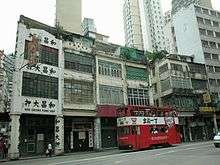
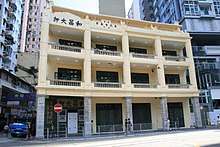
Tong lau are also found in Macau on Avenida de Almeida Ribeiro near the Largo do Senado. They are better preserved in Macau, where they did not give way to newer buildings. Upper floors no longer house people and often reused for commercial use. tong lau here often feature Portuguese colonial architectural influences.
Hong Kong
The existence of tong laus was a culmination of a series of historic forces from economic development of Hong Kong, Second World War as well as the influx of Chinese migrants to Hong Kong.[12]
In 1898, the government introduced a building and public health ordinance which defined all the buildings including tong laus. In 1903, the government introduced a maximum height per storey of 9 feet (2.7 m), with a four-storey limit. This explains the general appearance of Tong laus. Yet, the ordinance changed in 1962 which became fully operative in 1966, and no tong lau was built later.[13]
Tong laus are mainly distributed in the following areas in Hong Kong:
- Hong Kong Island
- Kennedy Town[14]
- Shek Tong Tsui[15]
- Sai Ying Pun[16]
- Nos. 145, 147, 149, 151, 153 Third Street[17]
- Sheung Wan[18]
- No. 1 Queen's Road West[19]
- Central[20]
- Nos. 172, 174, 176 Queen's Road Central / 123, 125, 127 Wellington Street[19]
- Nos. 17, 19 Shing Wong Street
- Nos. 1–12 Wing Lee Street[21]
- Wan Chai[22]
- Nos. 369, 371 Hennessy Road.[19] The building was demolished in 2015.
- Nos. 2, 4, 6, 8 Hing Wan Street[19] (Grade II)
- Nos. 60–66 Johnston Road[19]
- No. 8 King Sing Street[19]
- Nos. 1–11 Mallory Street and 6–12 Burrows Street (Green House) (Grade II)[19]
- Nos. 186–190 Queen's Road East (Grade II)[19][23]
- No. 6 Stewart Road[19]
- Nos. 72-74A Stone Nullah Lane (Blue House) (Grade I)[19]
- No. 18 Ship Street (Grade II)[19]
- Causeway Bay[24]
- Happy Valley[25]
- Tai Hang[26]
- North Point[27]
- Nos. 89, 91 Electric Road[19]
- Quarry Bay[28]
- Sai Wan Ho[29]
- Shau Kei Wan[30]
- Chai Wan
- Aberdeen[31]
- Tin Wan[32]
- Ap Lei Chau[33]
- Stanley[34]
- Kowloon
- Tsim Sha Tsui[35]
- Yau Ma Tei[36]
- Mong Kok[37]
- No. 119 Lai Chi Kok Road (Lui Seng Chun) (Grade I)[19]
- No. 729 Nathan Road[19]
- Nos. 1, 3 Playing Field Road[38]
- Nos. 177–179,[19] 190–204,[39] 210–212[39] Prince Edward Road West
- Nos. 600–606, 612, 614, 620–626 Shanghai Street[19][39] (Grade I)
- Tai Kok Tsui[40]
- Sham Shui Po[41]
- Nos. 187, 189 Apliu Street[19]
- No. 1235 Canton Road[19]
- Nos. 130, 132 Ki Lung Street[19]
- Nos. 117, 119, 121, 123, 125 Nam Cheong Street (Grade II)[19]
- No. 58 Pei Ho Street[19]
- No. 75 Un Chau Street[19]
- No. 170 Yee Kuk Street[19]
- Nos. 51, 53 Yen Chow Street[19]
- Nos. 269, 271 Yu Chau Street (Grade II)[19]
- Cheung Sha Wan[42]
- Shek Kip Mei[43]
- Hung Hom[44]
- To Kwa Wan[45]
- Ma Tau Wai[46]
- Ho Man Tin[47]
- Kowloon City[48]
- Wong Tai Sin[49]
- San Po Kong[50]
- Lok Fu[51]
- Tsz Wan Shan[52]
- Ngau Chi Wan[53]
- Kwun Tong[54]
- Ngau Tau Kok[55]
- Cha Kwo Ling[56]
- New Territories
- Kwai Chung[57]
- Tsuen Wan[58]
- Tuen Mun[59]
- Yuen Long[60]
- No. 31 Lee Yick Street, Yuen Long Kau Hui[19]
- Nos. 33–35 Nam Mun Hau, Yuen Long Kau Hui[19]
- Tai Wai[61]
- Tai Po[62]
- Luen Wo Hui[63]
- Sheung Shui[64]
- Sha Tau Kok[65]
- Nos. 1–22 San lau Street[19]
- Sai Kung Town[66]
- Tai O[67]
- Cheung Chau[68]
- Nos. 233, 234, 242 Tai San Back Street[19]
References
- Cecilia Chu (2012). "Between Typologies and Representation: The Tong Lau and the Discourse of the "Chinese House" in Colonial Hong Kong". Colonial Frames, Nationalist Histories: Imperial Legacies, Architecture, and Modernity (PDF).
- Chan, C. (2005). 空間之旅: 香港建築百年. p. 50–57. ISBN 9620424956.
- Charlie Q. L. Xue. Hong Kong Architecture 1945-2015: From Colonial to Global. Springer. p. 99. ISBN 9789811010040.
- Wong Wah Sang (2014). "Architectural Phenomena Following Law—Review of Residential Buildings in Hong Kong's Colonial Era" (PDF). Journal of Civil Engineering and Architectural Research. 1 (4): 215–229.
- Jun Zhang (2015). "Rise and Fall of the Qilou: Metamorphosis of Forms and Meanings in the Built Environment of Guangzhou" (PDF). Traditional Dwellings and Settlements Review. 26 (2): 26–40. Archived from the original (PDF) on 18 October 2015.
- Katy Chey. Multi-Unit Housing in Urban Cities: From 1800 to Present Day. Routledge. ISBN 9781317279754.
- Antiquities and Monuments Office – Lui Seng Chun Archived 22 May 2008 at the Wayback Machine
- Lee Ho Yin and Lynne DiStefano. "Tong Lau / 唐樓, the Hong Kong shophouse". Gwulo: Old Hong Kong.CS1 maint: uses authors parameter (link)
- https://www.canon.com.hk/en/club/article/itemDetail.do?itemId=10327
- "Report on the Collapse of the Building at 45J Ma Tau Wai Road, To Kwa Wan, Kowloon. Buildings Department, April 2010" (PDF). Retrieved 3 February 2012.
- Woon, Yuen-fong (1984). Social Organization in South China, 1911-1949. Ann Arbor, MI: Center for Chinese Studies, University of Michigan. pp. 49–57. ISBN 0892640510.
- "Urban Renewal Authority : 60 -66, Johnston Road". Ura.org.hk. Archived from the original on 7 August 2011. Retrieved 3 February 2012.
- Preservation lacks long-term vision. (26 November 2008). South China Morning Post., p.5.
- 堅尼地城唐樓集結 (Chinese)
- 400萬以下有貨西環細價樓回報逾3.5厘 西港島綫年底竣工 (Chinese) Archived 17 March 2017 at the Wayback Machine
- 西營盤唐樓變太空艙 月租4000元包家電 (Chinese)
- "Antiquities and Monuments Office – Introduction to 1444 Historic Buildings (Items #1159-1163)" (PDF). Retrieved 29 August 2013.
- 唐樓癡公開投資秘笈 翻新吸豪客 回報17厘 (Chinese)
- "Antiquities and Monuments Office – Introduction to 1444 Historic Buildings" (PDF). Retrieved 29 August 2013.
- 百年唐樓遺蹟隱身中環鬧市 團體斥古蹟辦忽視歷史價值 (Chinese)
- "Urban Renewal Authority : 10–12 Wing Lee Street". Ura.org.hk. Retrieved 3 February 2012.
- 灣仔87年轉角唐樓面臨清拆 街坊感可惜:呢類唐樓買少見少 (Chinese)
- "Urban Renewal Authority – 186–190, Queen's Road East". Ura.org.hk. Retrieved 22 February 2012.
- 銅鑼灣唐樓劏房 呎租58逼新盤價 170呎月租9800 外籍客承租 (Chinese)
- 跑馬地唐樓高價落釘 (Chinese)
- 戰前唐樓拒重建 大坑兩家人 (Chinese)
- 回流香港客815萬購北角唐樓 (Chinese)
- 太古洽購鰂魚涌三唐樓 (Chinese)
- 長綫放租博收購 西灣河唐樓300多萬有貨 重建掀尋寶熱 (Chinese) Archived 18 March 2017 at the Wayback Machine
- 筲箕灣唐樓升值百五倍 (Chinese)
- 港島唐樓價 跌破200萬元 (Chinese)
- 田灣街唐樓劏房失火母抱子危坐外牆獲救
- 鴨脷洲大街單幢樓執平貨
- 離島去到悶 轉場赤柱獨享天台BBQ嘆海景 (Chinese) Archived 19 March 2017 at the Wayback Machine
- 尖沙咀唐樓叫價6億 (Chinese)
- 區內多戰前唐樓 議員料研究有助保育 (Chinese)
- 旺角唐樓水表離奇被盜 警拘39歲無業漢 (Chinese)
- "Brief Information on Proposed Grade III Items. See pp 214–215" (PDF). Archived from the original (PDF) on 22 September 2013. Retrieved 3 February 2012.
- news.gov.hk – "20 pre-war shophouses to be preserved" (19 September 2008) Archived 6 October 2008 at the Wayback Machine
- 市建局收大角咀唐樓 呎價$13,614史上最高 (Chinese)
- 250呎深水埗唐樓大改造屏風加強空間感 (Chinese)
- 舊商號消失 頂層圍欄被拆 轉角唐樓 翻新失特色 (Chinese)
- 石硤尾唐樓起火 男住客吸入濃煙不適 (Chinese)
- 收購值四百億紅磡唐樓 離奇火燭兼漏水 (Chinese)
- 重建土瓜灣唐樓戶主歡迎冀102歲母不用行樓梯 (Chinese)
- 市建局重建馬頭圍唐樓 供逾400單位 (Chinese)
- 何文田唐樓 強拍底價4.13億 (Chinese)
- 九龍城400萬上車盤絕少 (Chinese)
- 黃大仙唐樓賣200萬 (Chinese)
- 炒家掃新蒲崗唐樓 (Chinese)
- 樂富唐樓回報38厘 (Chinese)
- 慈雲山唐樓售215萬 (Chinese)
- 牛池灣村 (Chinese)
- 一樓一古:觀塘月華街 180級富貴樓梯 (Chinese)
- 唐樓遇竊 失平板電腦及現金 (Chinese)
- 茶果嶺 淳樸樂土 (Chinese)
- 葵涌唐樓劏房疑遭縱火 住客抱B疏散 (Chinese)
- 荃灣市區(唐樓)環境研究及展望 (Chinese)
- 焦點故事:屯門私樓 170萬上車 (Chinese)
- 元朗盤大賤賣33萬平過深圳樓 (Chinese)
- 大圍唐樓套房租七千五 (Chinese)
- 阿婆也劏房 收租2.8萬 (Chinese)
- 粉嶺 聯和墟唐樓180萬起 (Chinese)
- 上水唐樓兩年冧價30% (Chinese)
- 禁區沙頭角墟 (Chinese)
- 西貢唐樓 賣本地好土產 (Chinese)
- 大澳被評級的歷史建築物 (Chinese)
- 長洲舊樓石屎剝落 飛墮行人路 (Chinese)
External links
| Wikimedia Commons has media related to Tong lau. |
- Lee Ho Yin (19 April 2010). "Pre-war tong lau: A Hong Kong Shophouse Typology" (PDF). Heritage World Media. Archived from the original (PDF) on 10 April 2016.
- Conserve and Revitalise Hong Kong Heritage
- Mallory Street/Burrows Street Project
- Heritage enthusiast battles against the wrecker's ball
- Old Qilou Buildings: Historical Architecture in Guangzhou (Part 1)
- Old Qilou Buildings: Historical Architecture in Guangzhou (Part 2)
- Tong Lau: A Hong Kong Shophouse Typology
- Hong Kong’s Disappearing Tong Lau (2017) by Stefan Irvine
- A Nostalgic Photo Trip of Tong Lau in Sheung Wan copyright by Canon (2017)

